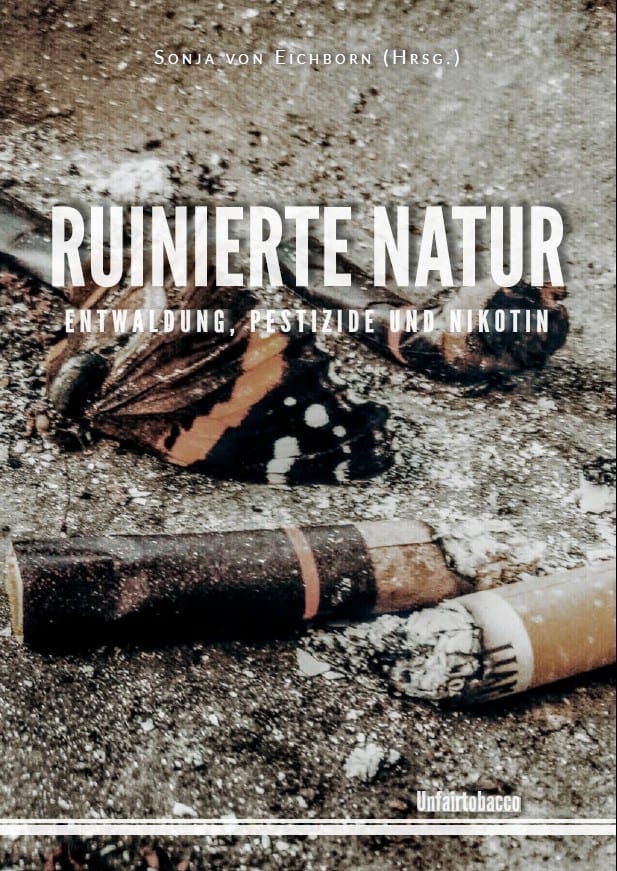Poison for waterbodies: nicotine and pesticides
Our new factsheet shows the impact of tobacco growing, cigarette manufacturing and cigarette butts on water, waterbodies and oceans.
Read moreNot for the diseases their products cause when used as intended. Not for the deforestation caused by tobacco cultivation or the contamination of soil and water caused by chemicals used on tobacco fields. Even not for the obvious waste, toxic waste, the removal of toxic cigarette butts.
Cigarette and leaf tobacco companies don’t pay for this. The price of tobacco is paid by flora and fauna, on land and under water. It is paid by humans, in tobacco growing areas, on sea coasts, in cities.
Our German study “Ruined Nature” highlights how the tobacco business harms the environment.
The production of 6 trillion cigarettes per year uses 22 billion tonnes of water, 5.3 million hectares of land, 62.2 gigajoules of energy, and 27.2 million tonnes of material resources. Every year, it causes 25 million tonnes of waste, 84 million tonnes of CO2 equivalent, and 55 million tonnes of waste water. The global tobacco industry thus has an ecological footprint comparable to countries like Peru or Israel. The scientists of Imperial College London who calculated these figures came to the following conclusion:
In other words, when smoking cigarettes, the developed world is literally burning poorer countries’ resources. (Zafeiridou/Hopkinson/Voulvoulis 2018)
The ecological footprint of the tobacco industry has very different effects on regional and local level. Our study “Ruined Nature” [German] takes a closer look at places where the price of tobacco is being paid.
In the tobacco growing areas of Tanzania, forests are cleared to make way for new tobacco fields and to supply the tobacco barns with fuelwood. Mwita M. Mangora shows the magnitude of deforestation in the miombo woodlands and the consequences for the local communities.
Read here his chapter “Tobacco takes its toll on the miombo woodlands”.
In Bangladesh, agrochemicals – fertilizers, fungicides, pesticides – used in tobacco cultivation contaminate the fertile river banks and the water of Matamuhuri river. Farida Akhter demonstrates how tobacco is occupying agricultural land and which consequences local communities face due to the diminishing fish stock.
Read here her chapter “Tobacco ruins soil and water along Matamuhuri river”.
In Germany, cigarette butts are a major concern. They are littered although they consist of plastic and contain many toxicants. Susanna Knotz describes how the German coastline of the Baltic Sea is affected and which actions against this contamination are already taken on a local level.
The tobacco sector is an unsustainable sector in which sustainable production and consumption patterns (SDG 12) are not achievable,
because, by definition, SDG 12 is about products that bring a better quality of life while minimizing the use of natural resources and toxic materials, and the emission of waste and pollutants over the product’s life cycle. (Zafeiridou/Hopkinson/Voulvoulis 2018)
Nevertheless, there are options to minimize the damages – in tobacco growing countries, in countries with large cigarette manufacturing or with high smoking prevalence. These require financial resources. It is time to use the concept of Extended Producer Responsibility for the tobacco industry. Multinational companies in the tobacco sector must pay their share of the price of tobacco.
Measures to be taken include for example fees or taxes to finance afforestation schemes and support farmers to switch to alternative crops, restrictions for tobacco cultivation like minimum distances to rivers and other water bodies, or financial contributions to bear the cost of tobacco waste management.
Read more in our study “Ruined Nature” [German].
There is absolutely no justification to destroy agricultural lands for a toxic plant that is a threat for life and livelihood. (Farida Akhter)
